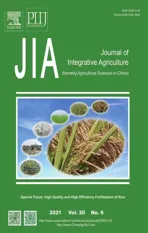Microbial community dynamics during composting of animal manures contaminated with arsenic,copper,and oxytetracycline
2021-05-23EbrahimSHEHATACHENGDengmiaoMAQianqianLIYanliLIUYuanwangFENGYaoJIZhenyuLIZhaojun
Ebrahim SHEHATA ,CHENG Deng-miao,MA Qian-qianLI Yan-liLIU Yuan-wangFENG YaoJI Zhen-yuLI Zhao-jun
1 Key Laboratory of Plant Nutrition and Fertilizer,Ministry of Agriculture and Rural Affairs/China–New Zealand Joint Laboratory for Soil Molecular Ecology,Institute of Agricultural Resources and Regional Planning,Chinese Academy of Agricultural Sciences,Beijing 100081,P.R.China
2 Department of Natural Resources and Agricultural Engineering,College of Agriculture,Damanhour University,Damanhour 22511,Egypt
3 Research Center for Eco-Environmental Engineering,Dongguan University of Technology,Dongguan 523808,P.R.China
Abstract Effects of the heavy metal copper (Cu),the metalloid arsenic (As),and the antibiotic oxytetracycline (OTC) on bacterial community structure and diversity during cow and pig manure composting were investigated. Eight treatments were applied,four to each manure type,namely cow manure with:(1) no additives (control),(2) addition of heavy metal and metalloid,(3) addition of OTC and (4) addition of OTC with heavy metal and metalloid;and pig manure with:(5) no additives (control),(6) addition of heavy metal and metalloid,(7) addition of OTC and (8) addition of OTC with heavy metal and metalloid. After 35 days of composting,according to the alpha diversity indices,the combination treatment (OTC with heavy metal and metalloid) in pig manure was less harmful to microbial diversity than the control or heavy metal and metalloid treatments.In cow manure,the treatment with heavy metal and metalloid was the most harmful to the microbial community,followed by the combination and OTC treatments. The OTC and combination treatments had negative effects on the relative abundance of microbes in cow manure composts. The dominant phyla in both manure composts included Actinobacteria,Bacteroidetes,Firmicutes,and Proteobacteria. The microbial diversity relative abundance transformation was dependent on the composting time. Redundancy analysis (RDA) revealed that environmental parameters had the most influence on the bacterial communities. In conclusion,the composting process is the most sustainable technology for reducing heavy metal and metalloid impacts and antibiotic contamination in cow and pig manure. The physicochemical property variations in the manures had a significant effect on the microbial community during the composting process. This study provides an improved understanding of bacterial community composition and its changes during the composting process.
Keywords:composting,heavy metal and metalloid,oxytetracycline,microbial community,principle component analysis,redundancy analysis
1.Introduction
Heavy metal and metalloid pollution is one of the most prevalent environmental problems that increases with industrial progress (Zakhamaet al.2011). The severity of these pollutants is compounded by the fact that they are non-biodegradable and accumulate through food chains.Heavy metals and metalloids,like copper (Cu) and arsenic(As),severely threaten human health and plant survival(Paz-Ferreiroet al.2013). The toxicity of Cu and As is a growing problem in animal manure management (Luet al.2017). Guoet al.(2012) showed that Cu and As restricted growth and diversity of the microbial communities during manure composting.
Antibiotics are widely used to protect animal health and improve feed-use efficiency during modern feeding processes (Sarmahet al.2006). As much as 30–90% of the applied antibiotics are excreted as their parent compounds or primary metabolites through faeces and urine (Kemper 2008;Yanget al.2019). Oxytetracycline (OTC) has a broad-spectrum antibacterial activity (Kumaret al.2005)and is used in animal feed to increase growth efficiency and improve the overall health of the animals (Liet al.2019). Like other antibiotic residues,OTC poses significant environmental concerns because it negatively affects the environment and human health (Zhanget al.2015).
Composting is the process that effectively and economically breaks down animal manures (Sunet al.2016;Zanget al.2017). The composting process has a clear impact on heavy metals and metalloids by affecting their movement and availability. It is noteworthy that the total concentration of heavy metals and metalloids increases after the composting process is over (Singh and Kalamdhad 2013). The water-soluble fractions of heavy metals and metalloids represent the most important fractions impacting on the environment and organisms (Ciavattaet al.1993).These fractions decrease during the composting process(Hsu and Lo 2001;Castaldiet al.2006;Irshadet al.2014).Several field and laboratory studies have been done to understand how the compost process effects tetracyclines degradation (Kimet al.2012). In 2009,Arikanet al.(2009) and coworkers studied OTC degradation during the composting process and concluded that OTC degradation was more than 99%. There is inadequate information on the biological dynamics that occur during the composting process. There are no regulations or guidelines that can be used to control microbiological properties during the composting process (Ryckeboeret al.2003). It has not been determined how microbial communities are affected by the methods and materials or by the heating and cooling phases used during the composting process (López-Gonzálezet al.2015). In general,the temperature changes during composting have a significant impact on the microbial community (López-Gonzálezet al.2015). It is important to study how the bacterial community changes during the composting process as it plays a key role in organic matter mineralization (Lazcanoet al.2008;Karadaget al.2013;Renet al.2016).
Traditional methods have been widely used for studying microbial diversity during composting (Oginoet al.2001;Egertet al.2004). Significant differences in bacterial populations between fresh manure and compost have been observed (Franke-Whittleet al.2014;Wanget al.2016)and differences in the relative abundances of populations have been observed during the composting process (Jianget al.2017). Microbial diversity was found to be higher in the thermophilic phase than in the mesophilic and curing phases (Partanenet al.2010;López-Gonzálezet al.2015;Wanget al.2015). During the thermophilic phase,the numbers of Firmicutes increased while Proteobacteria and Bacteroidetes decreased because of the rising temperature(Ryckeboeret al.2003). The most abundant bacteria in the thermophilic stage were Firmicutes (Dees and Ghiorse 2001;De Ganneset al.2013;Zhanget al.2016). Proteobacteria,Firmicutes,Bacteroidetes,and Actinobacteria were the dominant phyla in compost manure (Taibiet al.2012;Teixeira and Merquior 2014;Yinet al.2017). Proteobacteria,Bacteroidetes,and Actinobacteria were dominant in the later stages of composting (Zhanget al.2016).
This study followed changes in Cu,As,and OTC during composting. The aim of this study was to reduce antibiotic concentrations in manure and minimize the potential for heavy metal and metalloid pollution from animal manure.The main objectives of this study were:(1) to explore the behavior of heavy metal and metalloid transformation in the presence of an antibiotic;(2) to determine the relationship among residual antibiotics,heavy metal,metalloid fractions,microbial communities and environmental parameters during the composting process and ultimately,(3) to improve the efficiency of the composting process in the presence of heavy metals,metalloids and antibiotics.
2.Materials and methods
2.1.Composting procedure and sampling
Fresh cow and pig manures with low concentrations of heavy metals,metalloids and antibiotics were collected from largescale farms in Zhongyang County,Shanxi Province,China.The manure physiochemical properties,total copper (TCu),total arsenic (TAs),and OTC concentrations were analyzed(Table 1). Heavy metal,metalloid and OTC were added to the manures to give a total of eight treatments (Table 2)as follows:(1) cow manure with no additives (CC),(2) pig manure with no additives (PC),(3) cow manure with OTC(CO),(4) pig manure with OTC (PO),(5) cow manure with heavy metal and metalloid (CH),(6) pig manure with heavy metal and metalloid (PH),(7) cow manure with OTC,heavy metal and metalloid (COH) and (8) pig manure with OTC,heavy metal and metalloid (POH). The ingredients were mixed well and the mixture moisture was adjusted to about 60%. A total of 40 kg of each mixture was placed into a 240-L plastic box covered with a lid and incubated for 35 days. Each treatment was replicated three times.Samples were taken on days 1,3,5,7,14,21,and 35 from the start of incubation. The piles were turned every day and the temperature was monitored daily. On days 1,7,21 and 35 composite samples of compost were prepared by mixing three subsamples,respectively,taken from the bottom,middle and top layers of each pile. The samples were divided into two parts,and one part was stored at 4°C for the determination of physicochemical properties while the other part was stored at 20°C for the determination of microbial diversity.
2.2.Compost physicochemical analysis
Electrical conductivity (EC) and pH were determined using EC and pH meters (Bremner 1996). Total organic matter(TOM) was measured according to Dewis and Freitas(1970). Total nitrogen (TN) was measured by the Kjeldahl method with a KDY-9820 automatic Kjeldahl apparatus(Ruibang Technology Co.,Beijing,China) (Bremner 1965).TAs and TCu were determined by atomic absorption spectrometry (AAS) after digesting samples with aqua regia and fractionation according to Spositoet al.(1983). OTC was extracted and determined by high-performance liquid chromatography (HPLC) (Liet al.2010).
2.3.DNA extraction and bioinformatic statics analysis
Microbial DNA was extracted using a QIAGEN DNeasy PowerLyzer PowerSoil Kit (DP336;Tiangen Biotech,Beijing,China) and DNA concentrations were measured with Thermo Qubit. The 16S rRNA gene was amplified using Primers.16S rRNA extraction was carried out using the QIAquick Gel Extraction Kit (Qiagen,USA). The library fragment test was done using Quant Studio 6 (Applied Biosystems,USA) and a library concentration test with qPCR. The data were processed and filtered by eliminating readings with intermediate values of less than 20 and those that contained nitrogen bases of more than three by using the Flash program (Renet al.2016). The clean reads were arranged using USEARCH and filtered to obtain the optical taxonomic unit (OTU) cluster (Edgar 2013). Species were obtained by aligning all sequences representing the OTU.

Table 1 Selected physicochemical properties of composting materials1)

Table 2 Design of the cow and pig manure composting experiment
2.4.Statistical analysis
Principal component analysis (PCA) analysis was performed based on OTU values using the R software package. The alpha microbial diversity indexes (Chao1 and Shannon)were calculated for both cow and pig manure using the QIIME program (Edgaret al.2011;Bateset al.2013).Redundancy analysis (RDA) was carried out using the Canoco 5 Program to study the relationships between microbial diversity,compost physicochemical properties,heavy metal and metalloid extracts,and OTC concentration,according to Jianget al.(2017).
3.Results and discussion
3.1.Changes in physicochemical properties during composting
The temperature of the manure increased from the first day after incubation began (Appendices A and B),which is consistent with previous research by Yeet al.(2019) and exceeded 50°C in the first two weeks of incubation. The thermal periods during the composting process in which the temperature exceeded 50°C were 15 and 19 days in the control treatments for cow and pig manure,respectively.The highest temperatures recorded were on the seventh day of incubation and were 63°C and 60°C in the control treatments for cow and pig manure,respectively. The lowest temperatures recorded during the thermal period were less than 53 and 52°C,in the COH and POH treatments,respectively.
The EC increased markedly during incubation,in agreement with the results of Gulet al.(2015),while the pH decreased (Appendices A and B). In cow manure,EC values were the highest in the CH treatment,followed by the CO and COH treatments,while in pig manure,values were the highest in the PH and POH treatments and the lowest in the PC and PO treatments. The pH in cow manure was higher than that in pig manure. The values of pH decreased over time because of acid formation,as reported by Zorpaset al.(2008). pH is the primary variable for controlling ion reactions (Singh and Kalamdhad 2013;Yeet al.2019).TN and TOM decreased during incubation because of the mineralization process (Chaiet al.2016;Weiet al.2019).TOM concentrations were lowest in the COH and POH treatments. TN concentrations were highest in the CO,PO,COH and POH treatments.
3.2.Bioavailability of As and Cu during composting
Changes in TAs,TCu and the concentrations of low bioavailable (LF) and bioavailable fractions (BF) of As and Cu during the composting process in cow and pig manure are shown in Fig.1. The TAs and TCu in pig and cow compost increased with time. The highest concentrations of TCu and TAs in pig manure were in the PH and POH treatments. The TCu concentration in cow manure was significantly higher than in pig manure. However,there were no significant differences in the concentration of TAs during composting in either cow or pig manure.
The bioavailable fractions of heavy metals and metalloids are the forms that significantly affect plants and the environment. This fraction decreased for both Cu and As during composting (Fig.1),which is in accordance with the study of Amiret al.(2005). This effect minimizes the negative impact of heavy metals and metalloids in the environment. The thermophilic phase of composting reduces the bioavailable fractions of heavy metals and metalloids (Irshadet al.2014). Wanget al.(2008) stated that the bioavailable form of Cu is mainly transformed into the low bioavailable form,which is the least bioavailable form of Cu (Amiret al.2005),during the composting process.
3.3.OTC degradation during composting
The dissipation kinetics of OTC in the eight treatments(Fig.2) indicated a relatively faster dissipation of OTC in cow manure treatments than in pig manure treatments. This result was consistent with a previous study,in which OTC was persistent during cow manure composting (Storteboomet al.2007).
The OTC degradation rate on the first day of incubation in pig manure treatments was slower than in cow manure treatments (Fig.2). The OTC degradation rates during composting of both cow and pig manures were faster in the mixed treatment (i.e.,mixed treatments have a catalytic effect in OTC degradation) than in the OTC alone treatment.The degradation rate of OTC was greater than 90 and 83%in the OTC with heavy metal and metalloid treatment for pigs and cows,respectively. The degradation rate of OTC in mixed treatments on the final day was higher than for OTC alone treatments on the same day,which was less than 81%. The degradation rates of OTC in PH and CH treatments were faster than that in their related control treatments,which confirms the positive effect of heavy metal and metalloid (As and Cu) on OTC degradation. The degradation rate constants were 0.068 and 0.052 d–1in POH and COH treatments,respectively,which were higher than in PO and CO treatments. The constant values increased with the presence of As and Cu. The half-life (t1/2) values of OTC in POH and COH treatments were 10.2 and 13.3 days,respectively,which were significantly lower than those in the OTC treatment.
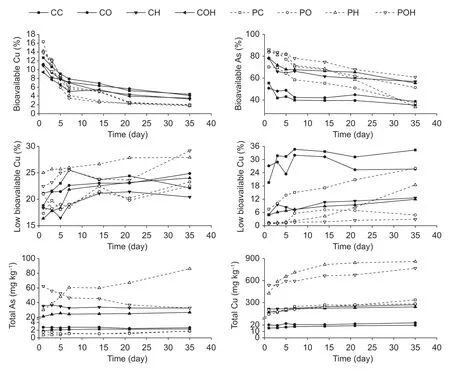
Fig.1 Changes in the concentrations of low bioavailable and bioavailable fractions,and total heavy metal copper (Cu) and metalloid arsenic (As) in eight treatments during cow and pig manure composting. CC,cow manure with no additives;CO,cow manure with oxytetracycline (OTC);CH,cow manure with heavy metal and metalloid;COH,cow manure with OTC,heavy metal and metalloid;PC,pig manure with no additives;PO,pig manure with OTC;PH,pig manure with heavy metal and metalloid;POH,pig manure with OTC,heavy metal and metalloid.
3.4.Principal component analysis
The community structures were analyzed based on the bacterial relative abundances using PCA in the composting process (Appendix C). In cow manure treatments,the first axis (PCA1) represented 49.63% of the variation during the experiment,while the second axis (PCA2) represented 25.87%. There were significant differences in community structures during the composting process of cow and pig manures. Additionally,in the thermal phase of composting,the community structures were significantly different from those at day 21 and day 35. There was no difference between day 21 and day 35. For the pig manure treatments,the first axis (PCA1) represented 51.76%,while the second axis (PCA2) represented 17.86% of the variation. The microbial diversity variation between the treatments on the first and seventh days did not change significantly. The variance of community structures at day 35 was more than those at day 1 and day 7,but much lower than at day 21.
3.5.Species abundance analysis
The relative abundance of the microbial community in cow manure treatments at the phylum level is reported in Fig.3.Bacterial community diversity and relative abundance varied significantly,and inversely,over time. The relative abundances of the main phyla at day 35 were higher than that at day 1 of composting. The microbial community structure shift during the composting process indicates that microbes adapted to the environment. Microbial diversity significantly increased in the thermophilic phase and gradually decreased in the cooling period. The results are consistent with previous studies (Partanenet al.2010;López-Gonzálezet al.2015;Wanget al.2015).
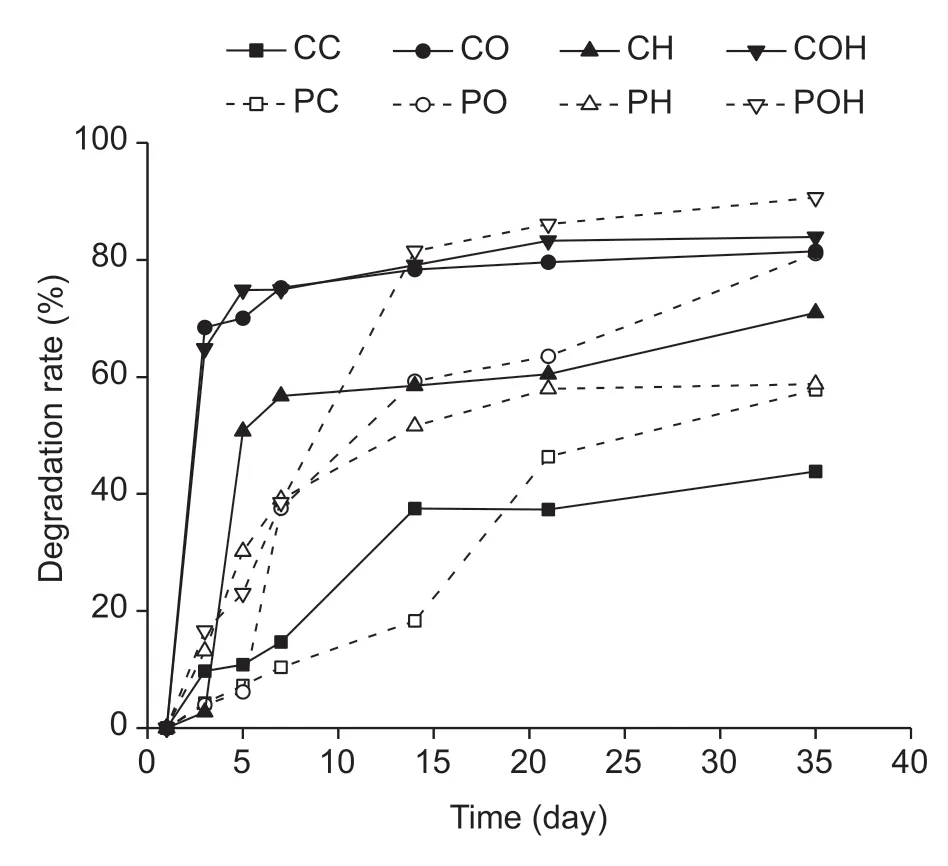
Fig.2 Degradation of oxytetracycline (OTC) in the eight treatments during cow and pig manure composting. CC,cow manure with no additives;PC,pig manure with no additives;CO,cow manure with OTC;PO,pig manure with OTC;CH,cow manure with heavy metal and metalloid;PH,pig manure with heavy metal and metalloid;COH,cow manure with OTC,heavy metal and metalloid;POH,pig manure with OTC,heavy metal and metalloid.
Arranged in descending order the phyla dominance was Firmicutes>Actinobacteria>Proteobacteria>Bacteroidetes.On the first day of composting,Firmicutes were the most dominant microbes recorded,comprising over 58% of microbes in all treatments,followed by Actinobacteria and Proteobacteria,which ranged from 1 to 22% of all microbes. On the seventh day (during the thermal phase),Firmicutes remained the most dominant phylum,and its presence increased more than 70% compared to the first day. The relative abundances of Proteobacteria and Actinobacteria decreased in all treatments compared to the first day of composting. After 21 days,Firmicutes(thermal bacteria) relative abundance decreased and ranged from 17 to 19%. In the CC and COH treatments,Actinobacteria was the dominant bacterial phylum,while Bacteroidetes was abundant in the CO and CH treatments. On the final day,the majority of microbes were Bacteroidetes (<24%) in all treatments followed by Actinobacteria and Proteobacteria. In cow manure,the common microbe order was:Firmicutes (at day 1 and day 7),followed by Actinobacteria,and Bacteroidetes(at day 21),and Bacteroidetes (at day 35). The relative microbe abundances were reduced in the heavy metal and metalloid treatment alone or with OTC at the first day and then increased in the remaining days. For OTC and control treatments,the relative microbe abundances were higher on the first day and then decreased on the seventh and final days.
In pig manure,there was a very different profile with bacterial dominance following the order:Proteobacteria>Firmicutes>Bacteroidetes (Fig.3).Proteobacteria had an absolute advantage with relative abundances of above 40%. However,on the seventh day,the dominant bacteria were Firmicutes,Bacteroidetes,Actinobacteria,and Proteobacteria. The Actinobacteria and Proteobacteria were the dominant microbes in the PC,POH and PO treatments,respectively.
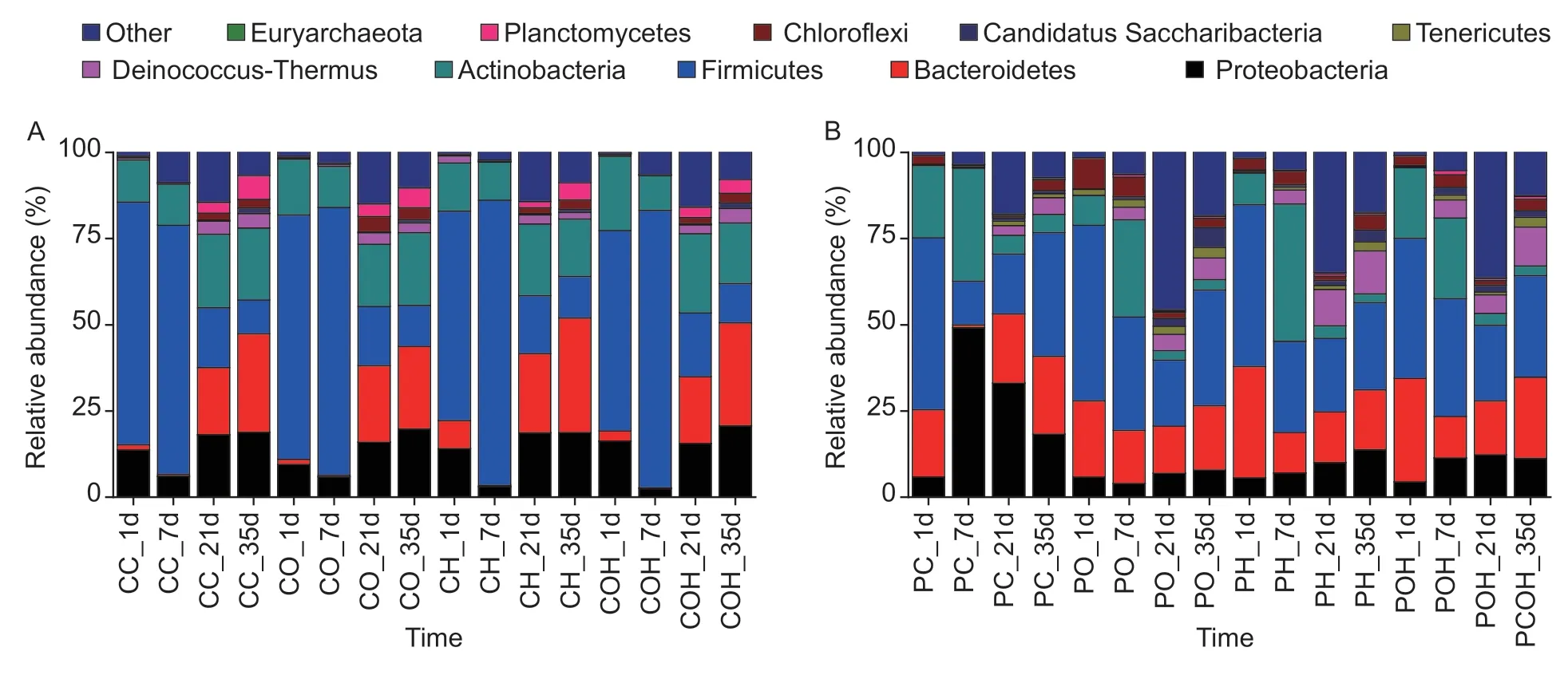
Fig.3 Dynamics of the bacterial community compositions at the phylum level in the eight treatments during the cow and pig manure composting. CC,cow manure with no additives;PC,pig manure with no additives;CO,cow manure with oxytetracycline (OTC);PO,pig manure with OTC;CH,cow manure with heavy metal and metalloid;PH,pig manure with heavy metal and metalloid;COH,cow manure with OTC,heavy metal and metalloid;POH,pig manure with OTC,heavy metal and metalloid.
In the PC treatment,Actinobacteria was abundant,while Proteobacteria was abundant in the PO and POH treatments. In the PH treatment,Firmicutes had the highest abundance,which increased during the first seven days of composting. The relative abundances of Proteobacteria and Bacteroidetes decreased over time. On the first day,the highest relative abundance values were in the PC and PO treatments. Actinobacteria abundance was 6% on the first day of composting and then increased significantly (to>49%). After 21 days,Proteobacteria and Bacteroidetes ratios were comparable in all treatments. At day 35 of composting,the relative abundance of Proteobacteria was the highest in all treatments,followed by Bacteroidetes. The relative microbe abundance was lower in the heavy metal and metalloid treatment alone or with OTC at day 1 and day 21 of composting. The lowest community abundance at the seventh day was in the OTC treatment alone or with heavy metal and metalloid,and the highest was in the control treatment. On the final day,the highest community abundances were in the control and OTC treatments,while the lowest were in the heavy metal and metalloid treatment alone or with OTC. Thus,heavy metal and metalloid alone or in combination with OTC had a negative effect on the relative abundance of bacteria. The common microbes in pig and cow manure were dependent on the composting time and different treatment materials. The results show that microbial diversity was affected by both OTC and Cu-As.
Our results were similar to those of other studies,which also showed that Proteobacteria,Bacteroidetes,Firmicutes,and Actinobacteria were the dominant phyla in composts(López-Gonzálezet al.2015;Wanget al.2016;Zhanget al.2016;Jianget al.2017;Wanget al.2017;Chenet al.2018). Firmicutes,with the greatest abundance during the thermophilic phase,are essential for the degradation of organic materials (Ryckeboeret al.2003;De Ganneset al.2013;Renet al.2016;Zhanget al.2016). Proteobacteria,Bacteroidetes,and Actinobacteria were dominant in the later stages of composting (Zhanget al.2016). These microbes release nutrients and promote humus formation,as well as the production of antibiotics to suppress pathogenic bacteria (Aravena-Románet al.2012;Neheret al.2013;Wanget al.2016).
3.6.Alpha diversity indices
Alpha diversity includes the Chao1 index and Shannon index,which were calculated using QIIME. Alpha diversity values for cow and pig manure treatments are shown in Appendix D.The Chao1 index in cow manure treatments increased during the composting process. The Chao1 index in the OTC treatment increased significantly at day 21 and day 35.For pig manure treatments,it decreased at day 7 significantly and then increased after the thermal period. The Chao1 index results showed that microbial diversity increased due to OTC degradation and low temperatures. In cow manure,at day 35,the Chao1 index value of the COH treatment was higher than the control and CH treatments but less than the CO treatment,while the value for the POH treatment was higher than that for the PH treatment and lower than those of the remaining treatments. The values of the Chao1 index decreased during the thermal period and increased after that period in both cow and pig treatments. The Chao1 index has been found to increase over time,with the lowest values being observed during the thermal period (Kimet al.2017),and showing a clear decrease during the thermophilic phase and then an increase (Menget al.2019). This result was in contrast with the results achieved by Jianget al.(2017),which showed that the abundance increased during high temperatures. Cu was an important factor that affected bacterial communities during the thermal and cooling phases(Yinet al.2018).
The Shannon diversity index has been traditionally used to measure the diversity of communities (Kimet al.2017),and it has been found to provide more information about community diversity than simple species richness or evenness measures (Lemoset al.2011). In the present study,the Shannon index showed that bacterial diversity in pig and cow manure decreased during the thermal phase and then increased. The Shannon value in the COH treatment at day 35 was higher than that in the CH treatment but less than that in the OTC treatment. At day 35,the OTC treatments for both pig and cow manure showed the highest bacterial diversity. In general,the OTC with heavy metal and metalloid treatment values decreased during the thermal period,and then they increased in the following days. The increase of the Shannon index was likely due to sufficient nutrient availability during the mesophilic phase (Wanget al.2013;Menget al.2019).
3.7.Redundancy analysis
RDA was used to evaluate the relationships between the bacterial community structure and environmental factors.The results showed that the selected variables explained 88.37 and 78.21% of the variance in cow and pig treatments,respectively (Fig.4). Temperature is usually the main environmental factor affecting the transformations of microbial communities. In the cow manure treatments,the first axis explained 83.17% and the second explained 5.2%of the variation in microbial diversity. There was an inverse correlation betweenand most environmental factors,and a positive correlation with the total heavy metal and metalloid concentrations and their bioavailable fractions(CuBF-AsBF). There were significant correlations between TN and OTC,TN and CuBF,and TN and AsBF. There was also a positive correlation between the total heavy metal and metalloid concentrations and their bioavailable fractions.The most important environmental factors affecting the microbial community during the composting process were TOM and,followed by pH.
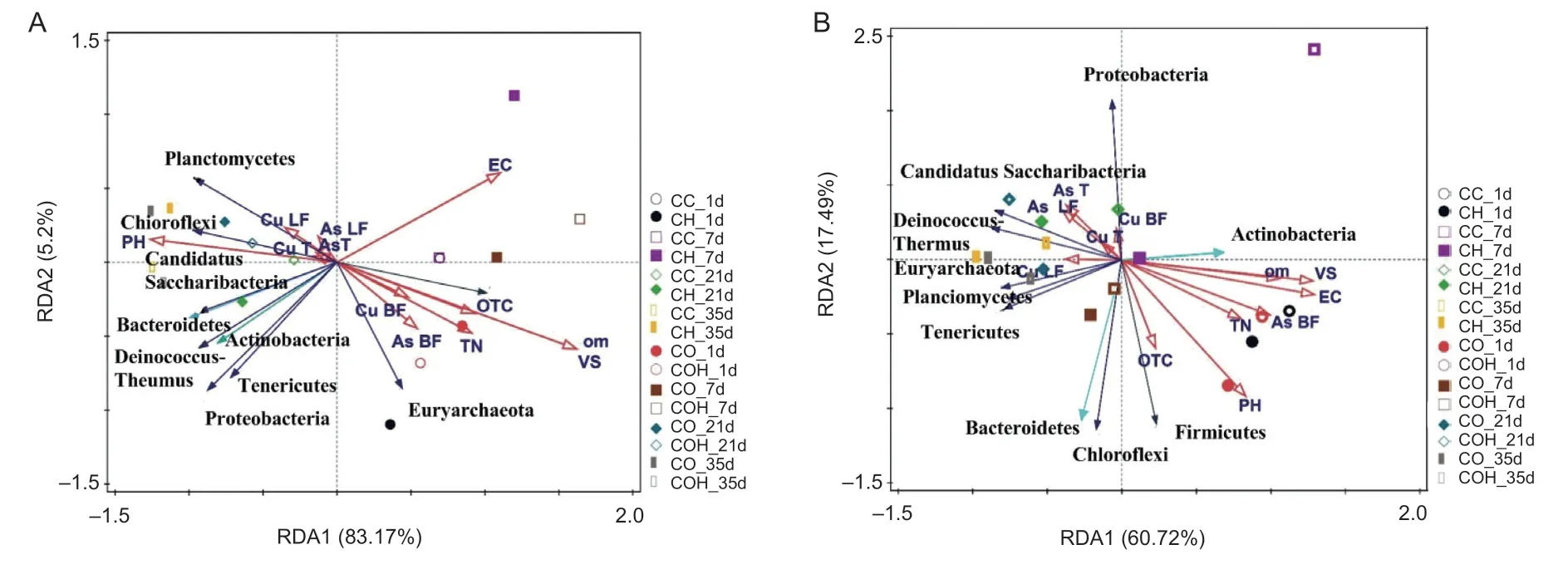
Fig.4 Redundancy analysis (RDA) based on the relationships between microbial relative abundance and the physicochemical parameters in the cow (A) and pig (B) manure composting on days 1,7,21 and 35. CC,cow manure with no additives;PC,pig manure with no additives;CO,cow manure with oxytetracycline (OTC);PO,pig manure with OTC;CH,cow manure with heavy metal and metalloid;PH,pig manure with heavy metal and metalloid;COH,cow manure with OTC,heavy metal and metalloid;POH,pig manure with OTC,heavy metal and metalloid.
The first and second axes explained 60.72 and 17.49%,respectively,of the microbial diversity variation during pig manure composting. There was a high correlation between OM,TN,and VS and high positive correlations between the total heavy metal and metalloid concentrations and their fractions. There were inverse correlations between(OM,EC,pH,TN,and AsBF) and other environmental factors. The environmental factors affecting the microbial community during the composting process are pH followed by EC and OM. During the thermal period,the most common microorganisms were Bacteroidetes,Tenericutes,Candidatus saccharibacteria,Chloroflexi,Planctomycetes,and Euryarchaeota.
Microorganisms are the drivers of organic waste degradation during composting (Zhouet al.2015).According to previous reports,the relationship between bacterial diversity and environmental parameters was affected by the composting material (Wanget al.2015) as well as by the composting stage (López-Gonzálezet al.2015). It has been reported that physicochemical properties significantly affect the microbial community composition during composting,andvice versa(Wanget al.2015). In our study,temperature changes during the composting process was the main environmental factor affecting the transformation of microbial communities,as reported in previous studies (Wanget al.2015,2016;Qianet al.2016).
According to the RDA analysis,the most important environmental factors affecting the microbial community during the composting process in cow manure were TOM,VS,and EC,followed by pH,while in pig manure they were pH followed by VS,EC and TOM. EC values representing salinity were intimately related to the microbial community structure changes. This was consistent with the previous observation by Belyaeva and Haynes (2012). A significant deviation in environmental pH can impose stress on these microorganisms. Previous studies have also found pH to be an important factor in affecting bacterial community diversity(Chodaket al.2015). According to the RDA analysis,positive correlations existed between pH and the relative abundances of thermophilic microbes (Renet al.2016).
4.Conclusion
Current trends in the management of heavy metal and antibiotic pollution are heading towards using composting technology. This study aimed to evaluate the potential ecological function and the efficacy of the composting process on the bacterial community structure and diversity change of manure contaminated with heavy metals and metalloids (Cu-As) and OTC. We conclude that the composting process had a significant effect on the physicochemical properties,heavy metal and metalloid immobilization and OTC degradation. A complex bacterial community in pig and cow manure treatments was clustered together as expected,and Firmicutes were the dominant microbial group during the thermal phase. Environmental factors,especially temperature,controlled the bacterial activity and community structure. Further studies are required to investigate the effects of the simultaneous removal of heavy metals and antibiotics and related ARGs by optimizing the composting conditions.
Acknowledgements
The work was supported financially by the National Key Technology R&D Program of China (2018YFD0500206),the National Natural Science Foundation of China (31572209,31772395 and 31972943),and the Foundation for Safety of Agricultural Products by Ministry of Agriculture and Rural Affairs,China (GJFP2019033).
Declaration of competing interest
The authors declare that they have no conflict of interest.
Appendicesassociated with this paper are available on http://www.ChinaAgriSci.com/V2/En/appendix.htm
杂志排行
Journal of Integrative Agriculture的其它文章
- Low glycemic index:The next target for rice production in China?
- Effect of side deep placement of nitrogen on yield and nitrogen use efficiency of single season late japonica rice
- Advancements in plant regeneration and genetic transformation of grapevine (Vitis spp.)
- Indica rice restorer lines with large sink potential exhibit improved nutrient transportation to the panicle,which enhances both yield and nitrogen-use efficiency
- Effects of nitrogen management on the ratoon crop yield and head rice yield in South USA
- Response of grain-filling rate and grain quality of mid-season indica rice to nitrogen application
